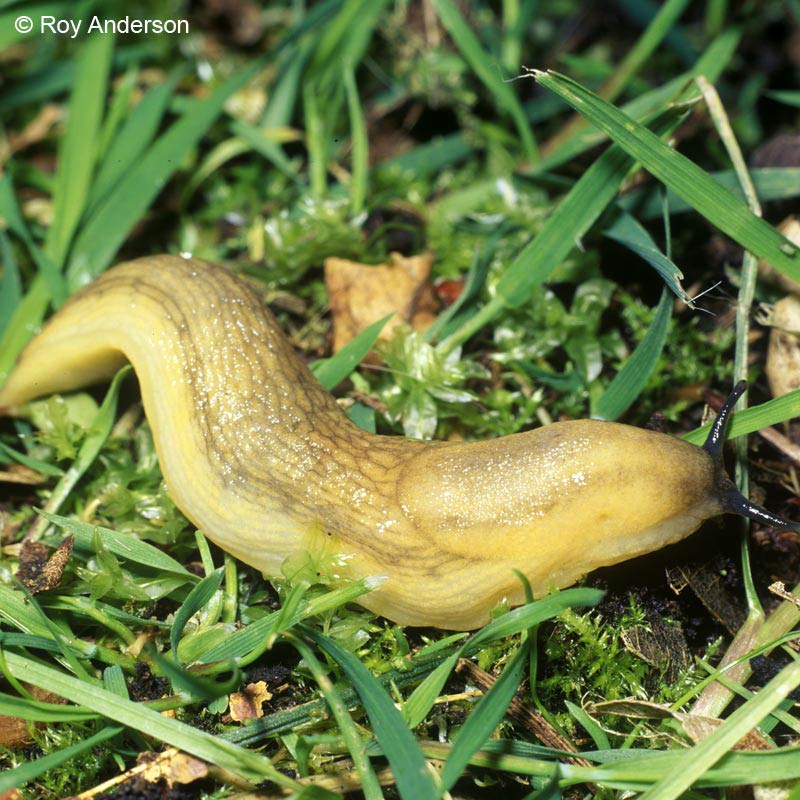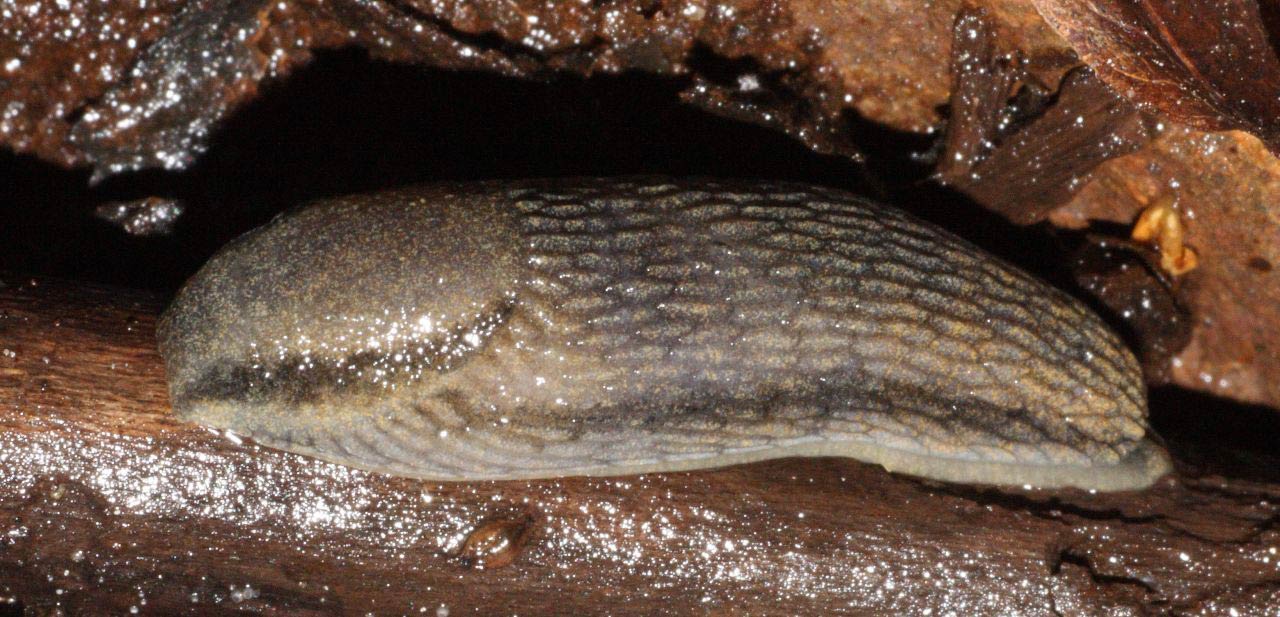Arion fasciatus group: Arion fasciatus
|
Arion fasciatus. (Photo: © Dr. Roy Anderson, MolluscIreland) |
|
Arion fasciatus. (Photo: © Dr. Roy Anderson, MolluscIreland) |
|
Arion fasciatus: contracted body (Photo: © Dr. Roy Anderson, MolluscIreland) |
|
Arion fasciatus. (Photo: © M. Flaten, Wikipedia) |
|
Arion fasciatus: genitalia. (Photo: © Kerney et al. 1983 modified by K. Weigel, University of Florida) |
Family
Arionidae
Species
Arion fasciatus (Nilsson, 1919)
Common name
White-soled slugSlug:
A snail that either does not possess a shell or has one that is very reduced (no definite coiling) or internal.
, Orange-banded arion
Description
This slugSlug:
A snail that either does not possess a shell or has one that is very reduced (no definite coiling) or internal.
belongs to a species complex that range in length from 30 to 40 mm as fully mature adults. This species-complex (Arion fasciatus group) contains the following species: Arion silvaticus, A. circumscriptus and A. fasciatus. Species in this group can be separated based on their genitaliaGenitalia:
The reproductive structures of an animal. May refer to either male or female structure.
. The body of the slugs is grayish centrally and white laterally with a pair of dark-colored stripes that run longitudinally. The stripes are often broken at the posteriorPosterior:
Directional term: the rear or tail end of an animal.
edge of the mantleMantle:
A fleshy, membranous covering of the anterior portion of the body of a mollusc. It secretes the materials that form the shell.
. The body often appears to have a granularGranular:
Bearing granules on the surface or having a rough appearance.
texture. There may also be a slight reddish color to the dorsal surface of the animal. The slightly granularGranular:
Bearing granules on the surface or having a rough appearance.
mantleMantle:
A fleshy, membranous covering of the anterior portion of the body of a mollusc. It secretes the materials that form the shell.
is rusty-gray in color and lacks markings except in Arion circumscriptus). A useful field identification characterCharacter:
1). A distinctive trait, quality or attribute used for recognizing, describing, or differentiating taxa; 2). The term used to denote such descriptive traits that possess states and are located within the Lucid version 2 (and later) interactive matrix panel. (compare feature)
for this species is the presence of a yellow flush below the dark lateral bands. The tentaclesTentacles:
Sensory projections on the head end of a mollusc. There are generally two pairs; upper (posterior) and smaller, lower (anterior). The upper pair bears the eyes. In many snails the eyes are located at the tips of this structure; however, in Basommatophoran snail species, the eyes are located at the base of the tentacles.
and headHead:
The area of a mollusc's body that has the tentacles, eyes and mouth.
are black in color. The pneumostomePneumostome:
This is the breathing hole on the right side of the mantle of molluscs. This allows air to pass through to the lung for gas exchange.(See also breathing pore).
(breathing pore) occurs in the anteriorAnterior:
Directional term: located in front. Nearer the head or front end of a shell.
one-third of the slug's mantleMantle:
A fleshy, membranous covering of the anterior portion of the body of a mollusc. It secretes the materials that form the shell.
on the right side of the body. In contracted individuals the body is bell-shaped. No keelKeel:
Also known as the carina. This is a longitudinal ridge that runs dorsally along the apex of the tail of the animal.
is present in this group; however, an enlarged row of pale colored tuberclesTubercles:
An enlarged or raised region on the body of a slug. The shape of this structure is very variable. (See also tubercle)
may create an impression that one may exist (false keelKeel:
Also known as the carina. This is a longitudinal ridge that runs dorsally along the apex of the tail of the animal.
). As the common name (White-soled slugSlug:
A snail that either does not possess a shell or has one that is very reduced (no definite coiling) or internal.
) suggests, the sole of this species-complex is pale colored, similar to the footFoot:
The muscular organ on the undersurface of the body of a mollusc upon which the animal rests or uses to crawl.
fringe. The mucus secreted by this group is colorless or yellow. Molecular techniques can also be used to identify members of this group.
Genitalic characters used to distinguish the three species:
Arion fasciatus: genitalia Genitalia:
The reproductive structures of an animal. May refer to either male or female structure.
with a short atriumAtrium:
Opening or passage of the genitalia. OR Region for the reception of gametes.
, a narrow oviduct and an unpigmented thick epiphallus.
Arion circumscriptus: genitalia Genitalia:
The reproductive structures of an animal. May refer to either male or female structure.
with a long narrow atriumAtrium:
Opening or passage of the genitalia. OR Region for the reception of gametes.
, a relatively narrow oviduct and a pigmented epiphallus.
Arion silvaticus: genitalia Genitalia:
The reproductive structures of an animal. May refer to either male or female structure.
with a long atriumAtrium:
Opening or passage of the genitalia. OR Region for the reception of gametes.
, a broad oviduct and an unpigmented narrow epiphallus.
Native range
Northwestern Europe
Distribution
North America:
- U.S.: Kentucky, Northern United States
- Canada: Ontario, Quebec, Newfoundland
Ecology
The slugs in the Arion fasciatus group are typically found in disturbed habitats; however, they commonly invade natural areas. The brown-banded arion (Arion circumscriptus) is primarily nocturnalNocturnal:
Occurring or becoming active at night.
. All three species have been reported in greenhouses and may become a serious agricultural pest. Reproduction is primarily through self-fertilizationSelf-fertilization:
This is an event where an organism is produced by the fertilization of an egg by sperm from the same organism. (See also hermaphrodite)
.
Synonyms
- Limax fasciatus Nilsson, 1823 (non 1822)
- Arion nilssoni Pollonera, 1887
References
Anderson 2005; Branson 1959; Hutchinson and Heike 2007; Grimm et al. 2009; Kantor et al. 2009; Kerney et al. 1979; Thomas et al. 2010






